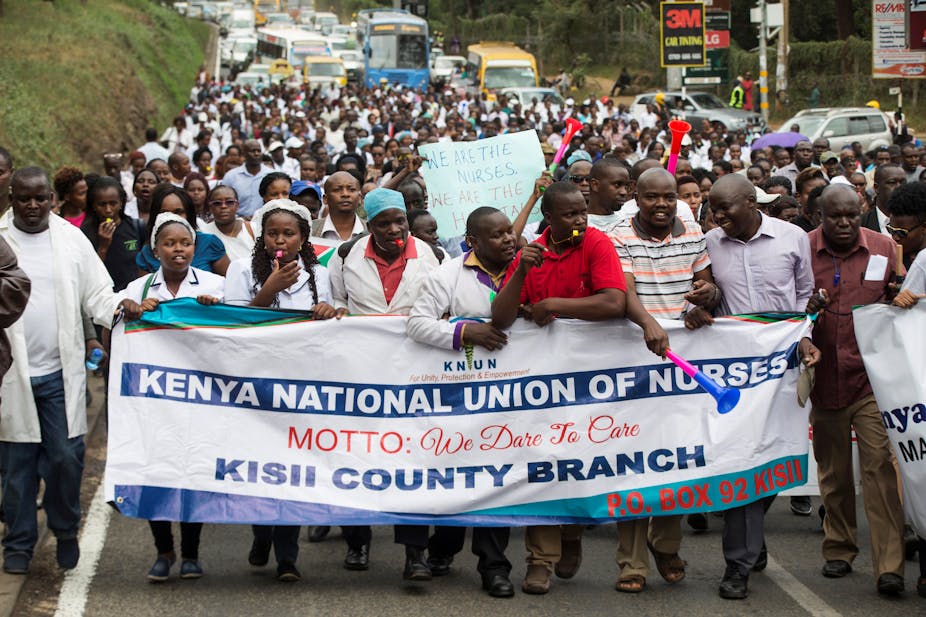Nurses in Kenya’s public hospitals have been on strike since June, paralysing health care services countrywide.
At the centre of their dispute is a collective bargaining agreement that had been struck with county governments through the council of governors. The agreement addresses pay, working conditions and promotions. But it’s not been honoured by the governors because they say it’s too costly and hasn’t been cleared by the salaries and remunerations commission. The commission’s mandate is to set and regularly review salary and benefits of all state officers and to advise the government on remuneration and benefits of other public servants.
The government has responded to the impasse by threatening to sack the nurses and freezing their salaries.
Some nurses have gone back to work, though most remain on strike.
The nurses strike began less than three months after a doctors’ strike that lasted for 105 days. It had a devastating effect on the health sector as essential health services such as antenatal clinics, care of mothers during delivery, immunising babies and attending to patients with chronic diseases were not offered.
The strike has overwhelmed the two national referral hospitals; Kenyatta National Hospital in Nairobi and the Moi Teaching and Referral hospital in Western Kenya because they are treating patients who should have been served at the peripheral health facilities.
Many expectant mothers are giving birth at home while some patients have had to travel to neighbouring countries like Tanzania for treatment.
There is also a danger that the significant gains Kenya has made in the fight against childhood illnesses such as pneumonia, diarrhoea and measles could be reversed.
Calling for better pay
The Kenya National Union of Nurses, the trade union representing the nurses, has made major concessions in the salary negotiations by bringing down their pay demands.
The 26,000 nurses also want a uniform allowance, a risk allowance and changes to entry level for new employees.
Kenyan nurses work under difficult conditions. Understaffing is acute, particularly in remote dispensaries and health centres where they performs duties normally done by clinicians or pharmaceutical technologists.
The situation has deteriorated over the past four years since the government devolved health services from national to county level.
While counties are now responsible for labour relations, they rely on the national government for funds to pay salaries. This binds the council of governors from giving increments without a guarantee of approval from the national government.
Strikes in the health sector have been driven by factors such as the fact that:
Counties have weak human resource management structures marred by claims of poor working conditions, corruption, nepotism and tribalism. The lack of proper structures has eroded the confidence of workers leading to an exodus to the private sector and to other countries. Nurses in Kenya have emigrated to work in southern African countries such as Namibia, Botswana and developed countries like the United Kingdom , Canada,USA and Australia in search of better pay.
Devolution of health care services was done haphazardly without passing the requisite health bill into law. The nascent county structures were ill prepared to deal with the colossal burden of health care workers.
The rising cost of living and inflation for all workers countrywide has also fuelled the unrest. If this is not controlled, then workers across all sectors will continue to clamour for pay increases to meet the rising cost of living.
Averting health workers’ strikes
To end health worker strikes, a number of crucial steps need to be taken.
Firstly, the government needs to appreciate that it shares mutual interests with employees and should work with unions to reduce conflict and promote productivity.
Secondly, the government should encourage trust among all parties. Industrial relations should be anchored on good faith, mutual trust and respect. The parties must engage with honesty, transparency and integrity.
Thirdly, a much deeper relationship needs to be established between the government and the workers’ unions so that there’s constant engagement between the two sides before tensions deteriorate into strikes. Trade unions should also be engaged in major policy decisions that affect the sector.
And lastly, the government should create a conducive working environment, including ongoing improvements in the conditions and terms of work to address both workers’ and patients’ needs. As the employer, it should ensure that workers are treated fairly, and that issues such as training, deployment and disciplinary measures are properly managed. This would attract health care workers, improve retention and reduce industrial unrest
In the long run, Kenya urgently needs three key entities to come to the party to fix the country’s health care system.
The county health departments must fight for enough resources from the central government to be able to provide quality services. They also need to step up and prove that they can manage health workers effectively or surrender the role back to the central government.
Health workers need to be more vocal and proactive against flaws in the way health care is run, and to correct the current state of things.
And finally the public needs to agitate for improved health care services by calling on governors and other leaders to account for poor services. Kenyans are guaranteed quality health service by the country’s constitution. They shouldn’t settle for anything less.

